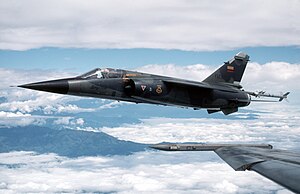Dassault Mirage F1
| Mirage F1 | |
|---|---|
 |
|
| An Ecuadorian Air Force Mirage F1JA (a variant of the F1E multi-role fighter) | |
| Role | Fighter aircraft |
| Manufacturer | Dassault Aviation |
| First flight | 23 December 1966 |
| Introduction | 1973 |
| Status | Retired from the French Air Force operational service in June 2014. In service in Gabon, Iran, Libya and Morocco |
| Primary users |
French Air Force (historical) Iraqi Air Force (historical) Hellenic Air Force (historical) Spanish Air Force(historical) |
| Produced | 1966–1992 |
| Number built | 720+ |
| Developed from | Dassault Mirage III |
The Dassault Mirage F1 is a French fighter and attack aircraft designed and built by Dassault Aviation as a successor of the Mirage III family. The Mirage F1 entered service in the French Air Force (Armée de l'Air) in 1974. Powered by a single SNECMA Atar turbojet providing about 7 tonnes-force (69 kN; 15,000 lbf) of thrust, the F1 has been used as a light multipurpose fighter and has been exported to about a dozen nations. More than 720 F1s have been produced.
Dassault designed the Mirage F1 as a private venture, using its own funds, as a successor to its Mirage III and Mirage 5 fighters, with the F1 being a smaller version of the Mirage F2 being developed for the French Air Force. It was of similar size to the delta-winged Mirage III and V, and was powered by a SNECMA Atar 9K turbojet as used in the Dassault Mirage IV, but unlike its predecessors, it shared the layout of a swept wing mounted high on the fuselage and a conventional tail surface as used by the F2. Although it has a smaller wingspan than the Mirage III, the F1 nevertheless proved to be superior to its predecessor. It can carry up to 43% more fuel, has a shorter take-off run and better maneuverability.
The first prototype made its maiden flight on 23 December 1966. Despite the prototype crashing on 18 May 1967 due to flutter, killing its pilot, an order for three prototypes was placed on 26 May 1967, the larger and more expensive F2 being abandoned.
In order to comply with the French Air Force's requirement for an all-weather interceptor, the first production Mirage F1C was equipped with a Thomson-CSF Cyrano IV monopulse radar. The later Cyrano IV-1 version added a limited look-down capability. However Mirage F1 pilots reported that the radar can easily overheat, reducing its efficiency. First deliveries to the French Air Force took place in May 1973, entering squadron service with EC 2/30 Normandie-Niemen in December that year. Initially, the aircraft was armed with two internal 30 mm cannons, and a single Matra R530 medium-range air-to-air missile carried under the fuselage.
...
Wikipedia
